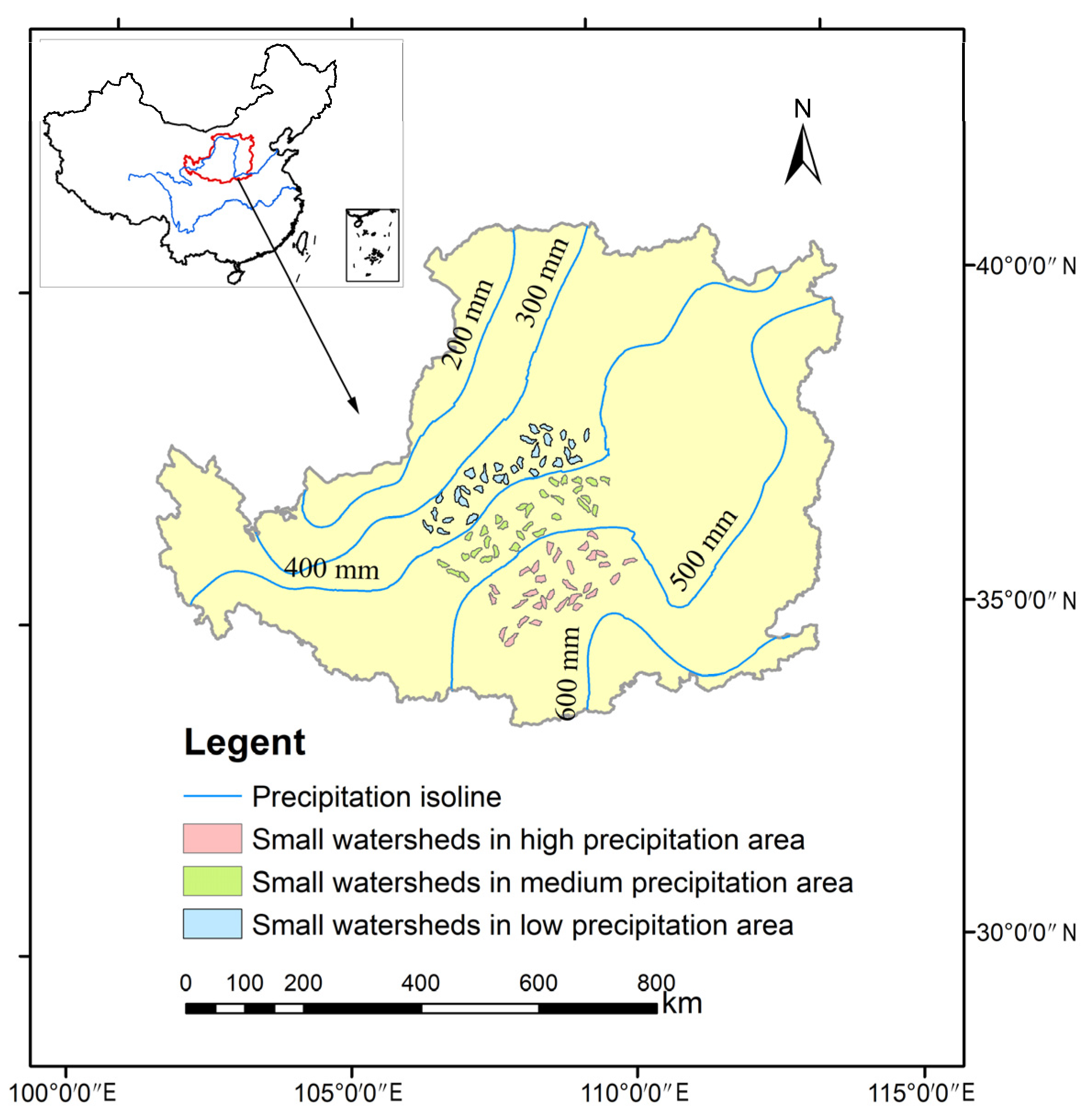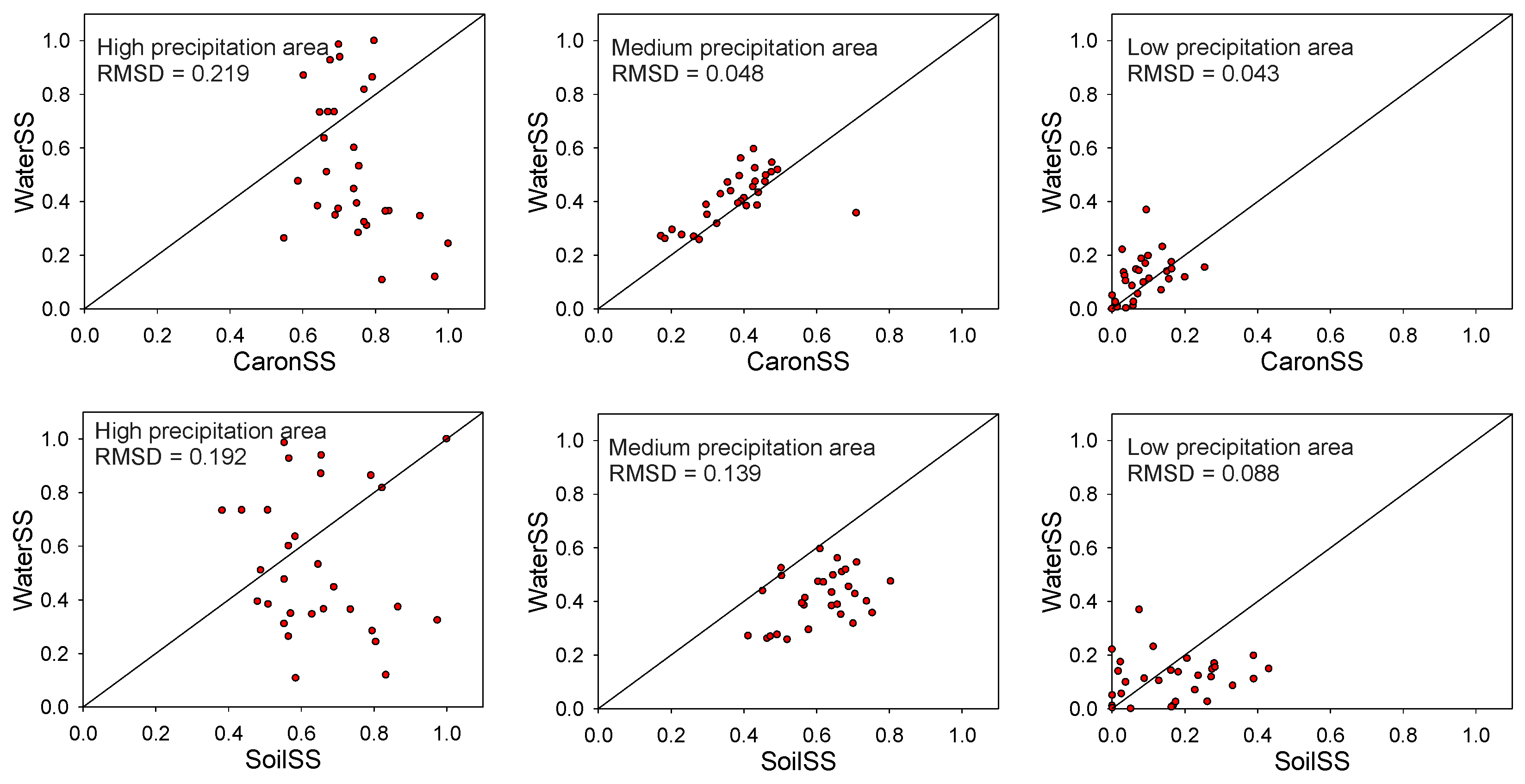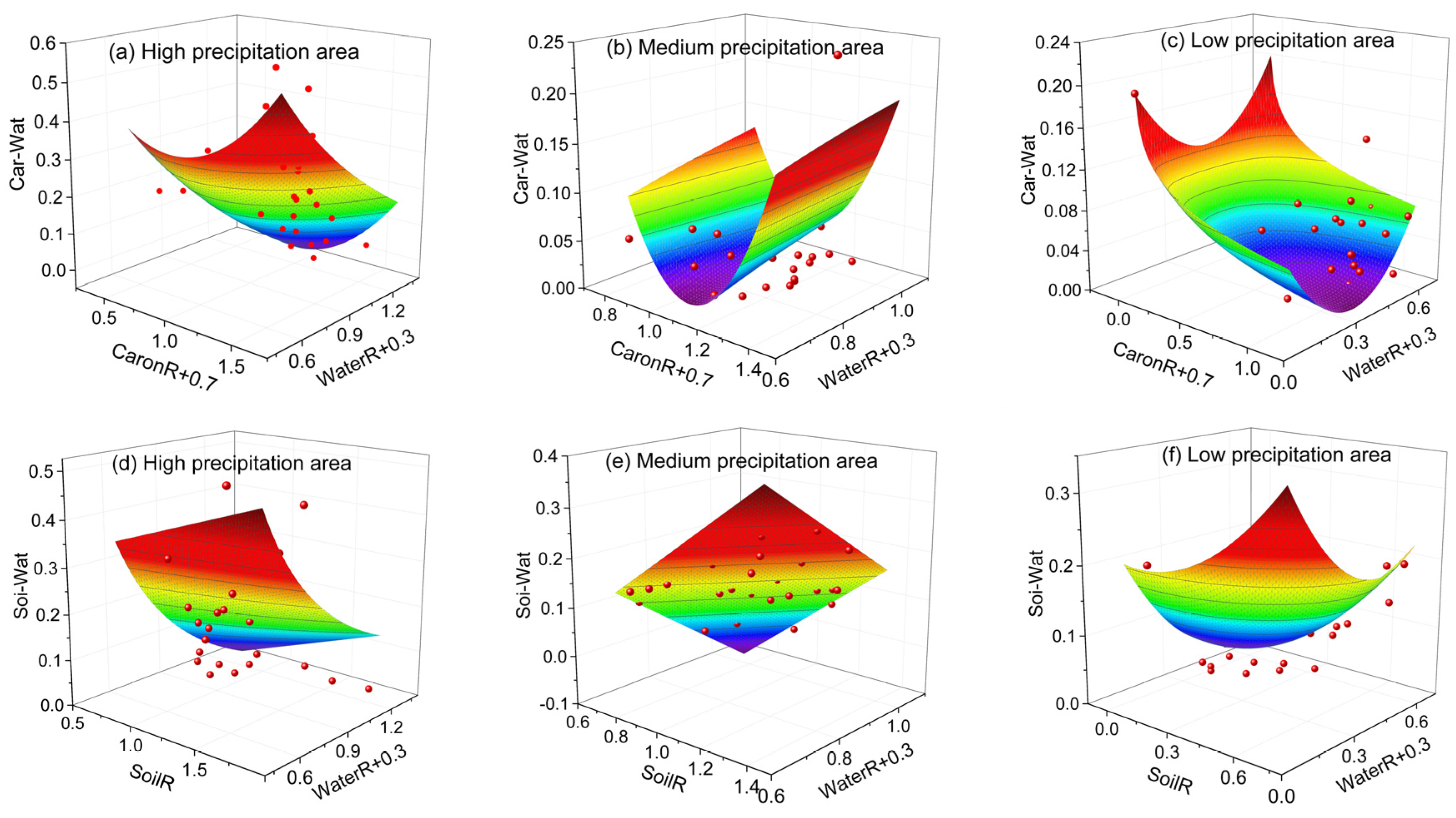Relationship between Ecosystem-Services Trade-Offs and Supply–Demand Balance along a Precipitation Gradient: A Case Study in the Central Loess Plateau of China
Abstract
:1. Introduction
2. Materials and Methods
2.1. Study Area
2.2. Data Sources
2.3. Calculation of Supply and Demand for ESs
2.4. Calculation of the Size of Trade-Offs in ESs
2.5. Quantitative Calculation of Supply–Demand Balance of ESs
2.6. Statistical Analysis
3. Results
3.1. Characteristics of Changes in ESs Supply, Demand and Balance between Supply and Demand along the Precipitation Gradient
3.2. Characteristics of Changes in Trade-Offs between ESs along the Precipitation Gradient
3.3. The Factors Influencing Ecosystem Services Supply–Demand Balance
3.4. The Factors Influencing Ecosystem Services Trade-Offs
3.5. The Characteristics of the Linkage between Ecosystem-Services Supply–Demand Dynamics and Trade-Offs
4. Discussion
4.1. Spatial Differentiation of ESs in Different Geographical Spaces
4.2. Diversity of Factors Affecting Supply, Demand and Trade-Offs of ESs
4.3. The Intrinsic Mechanism of the Correlation between Supply–Demand Dynamics and Trade-Offs in ESs
4.4. The Limitations of this Study and Prospective Future Studies
5. Conclusions
Author Contributions
Funding
Data Availability Statement
Conflicts of Interest
References
- Costanza, R.; D’Arge, R.; de Groot, R.; Farber, S.; Grasso, M.; Hannon, B.; Limburg, K.; Naeem, S.; O’Neill, R.V.; Paruelo, J.; et al. The Value of the World’s Ecosystem Services and Natural Capital. Nature 1997, 387, 253–260. [Google Scholar] [CrossRef]
- Millennium Ecosystem Assessment. Ecosystem and Human Well-Being; Island Press: Washington, DC, USA, 2005; pp. 137–142. [Google Scholar]
- Bennett, E.M.; Peterson, G.D.; Gordon, L.J. Understanding Relationships among Multiple Ecosystem Services. Ecol. Lett. 2009, 12, 1394–1405. [Google Scholar] [CrossRef] [PubMed]
- Matsuzaki, S.S.; Kohzu, A.; Kadoya, T.; Watanabe, M.; Osawa, T.; Fukaya, K.; Komatsu, K.; Kondo, N.; Yamaguchi, H.; Ando, H.; et al. Role of wetlands in mitigating the trade-off between crop production and water quality in agricultural landscapes. Ecosphere 2019, 10, e02918. [Google Scholar] [CrossRef]
- Segre, H.; Carmel, Y.; Shwartz, A. Economic and not ecological variables shape the sparing–sharing trade-off in a mixed cropping landscape. J. Appl. Ecol. 2022, 59, 779–790. [Google Scholar] [CrossRef]
- Biel, R.G.; Hacker, S.D.; Ruggiero, P. Coastal protection and conservation on sandy beaches and dunes: Context-dependent tradeoffs in ecosystem service supply. Ecosphere 2017, 8, e01787. [Google Scholar] [CrossRef]
- Mouchet, M.; Lamarque, P.; Martín-López, B. An Interdisciplinary Methodological Guide for Quantifying Associations between Ecosystem Services. Glob. Environ. Change 2014, 28, 298–308. [Google Scholar] [CrossRef]
- Cortinovis, C.; Geneletti, D. A performance-based planning approach integrating supply and demand of urban ecosystem services. Landsc. Urban Plan. 2020, 201, 103842. [Google Scholar] [CrossRef]
- Kroll, F.; Mueller, F.; Haase, D.; Fohrer, N. Rural-urban gradient analysis of ecosystem services supply and demand dynamics. Land Use Policy 2012, 29, 521–535. [Google Scholar] [CrossRef]
- Arnaiz-Schmitz, C.; Herrero-Jáuregui, C.; Schmitz, M.F. Recreational and nature-based tourism as a cultural ecosystem service: Assessment and mapping in a rural-urban gradient of central Spain. Land 2021, 10, 343. [Google Scholar] [CrossRef]
- Lu, N.; Liu, L.; Yu, D. Navigating trade-offs in the social-ecological systems. Curr. Opin. Environ. Sustain. 2021, 48, 77–84. [Google Scholar] [CrossRef]
- Neyret, M.; Fischer, M.; Allan, E. Assessing the Impact of Grassland Management on Landscape Multifunctionality. Ecosyst. Serv. 2021, 52, 101366. [Google Scholar] [CrossRef]
- Tan, J.; Peng, L.; Wu, W.; Huang, Q. Mapping the evolution patterns of urbanization, ecosystem service supply–demand, and human well-being: A tree-like landscape perspective. Ecol. Indic. 2023, 154, 110591. [Google Scholar] [CrossRef]
- Zheng, H.; Wang, L.J.; Wu, T. Coordinating ecosystem service trade-offs to achieve win–win outcomes: A review of the approaches. J. Environ. Sci. 2019, 82, 103–112. [Google Scholar] [CrossRef] [PubMed]
- Li, X.; Yu, X.; Wu, K.N. Land-use zoning management to protect the regional key ecosystem services: A case study in the city belt along the Chaobai River, China. Sci. Total Environ. 2020, 762, 143167. [Google Scholar] [CrossRef] [PubMed]
- Wang, L.J.; Zheng, H.; Wen, Z. Ecosystem service synergies/trade-offs informing the supply-demand match of ecosystem services: Framework and application. Ecosyst. Serv. 2019, 37, 100939. [Google Scholar] [CrossRef]
- Zhang, H.; Zhang, Z.; Liu, K.; Huang, C.; Dong, G. Integrating land use management with trade-offs between ecosystem services: A framework and application. Ecol. Indic. 2023, 149, 110193. [Google Scholar] [CrossRef]
- Fang, G.; Sun, X.; Sun, R.; Liu, Q.; Tao, Y.; Yang, P.; Tang, H. Advancing the optimization of urban–rural ecosystem service supply–demand mismatches and trade-offs. Landscape Ecol. 2024, 39, 32. [Google Scholar] [CrossRef]
- Bottalico, F.; Pesola, L.; Vizzarri, M.; Antonello, L.; Barbati, A.; Chirici, G.; Corona, P.; Cullotta, S.; Garfi, V.; Giannico, V.; et al. Modeling the influence of alternative forest management scenarios on wood production and carbon storage: A case study in the Mediterranean region. Environ. Res. 2016, 144, 72–87. [Google Scholar] [CrossRef] [PubMed]
- Kim, M.; Kraxner, F.; Forsell, N.; Song, C.; Lee, W.K. Enhancing the provisioning of ecosystem services in South Korea under climate change: The benefits and pitfalls of current forest management strategies. Reg. Environ. Change 2021, 21, 6. [Google Scholar] [CrossRef]
- Feng, Q.; Zhao, W.W.; Hu, X.P. Trading-off ecosystem services for better ecological restoration: A case study in the Loess Plateau of China. J. Clean. Prod. 2020, 257, 120469. [Google Scholar] [CrossRef]
- Hu, B.; Zhang, Z.; Han, H. The Grain for Green Program intensifies trade-offs between ecosystem services in midwestern Shanxi, China. Rem. Sens. 2021, 13, 3966. [Google Scholar] [CrossRef]
- Feng, X.M.; Fu, B.J.; Piao, S.L. Revegetation in China’s Loess Plateau is approaching sustainable water resource limits. Nat. Clim. Change 2016, 6, 1019–1022. [Google Scholar] [CrossRef]
- Chen, Y.P.; Wang, K.B.; Lin, Y.S. Balancing green and grain trade. Nat. Geosci. 2015, 8, 739–741. [Google Scholar] [CrossRef]
- Zhang, Y.; Huang, M.; Lian, J. Spatial distributions of optimal plant coverage for the dominant tree and shrub species along a precipitation gradient on the central Loess Plateau. Agric. For. Meteorol. 2015, 206, 69–84. [Google Scholar] [CrossRef]
- Wang, C.; Wang, S.; Fu, B.; Li, Z.; Wu, X.; Tang, Q. Precipitation gradient determines the tradeoff between soil moisture and soil organic carbon, total nitrogen, and species richness in the Loess Plateau, China. Sci. Total Environ. 2017, 575, 1538. [Google Scholar] [CrossRef] [PubMed]
- Feng, Q.; Dong, S.Y.; Duan, B.L. The effects of land-use change/conversion on trade-offs of ecosystem services in three precipitation zones. Sustainability 2021, 13, 13306. [Google Scholar] [CrossRef]
- Jian, Z.; Sun, Y.; Wang, F.; Zhou, C.; Pan, F.; Meng, W.; Sui, M. Soil conservation ecosystem service supply-demand and multi-scenario simulation in the Loess Plateau, China. Glob. Ecol. Conserv. 2024, 49, e02796. [Google Scholar] [CrossRef]
- Ma, Y.; Chen, H.; Liu, D.; Zhang, J.; Yang, M.; Shi, J. Identification and management of priority regulation areas based on the supply–demand relationship of ecosystem services: A case study of the Loess Plateau. Ecol. Indic. 2024, 159, 111754. [Google Scholar] [CrossRef]
- Li, J. Identification of ecosystem services supply and demand and driving factors in Taihu Lake Basin. Environ. Sci. Pollut. Res. 2022, 29, 29735–29745. [Google Scholar] [CrossRef]
- Sharp, R.; Tallis, H.T.; Ricketts, T.; Guerry, A.D.; Wood, S.A.; Chaplin-Kramer, R. InVEST + VERSION User’s Guide; The Natural Capital Project, Stanford University: Stanford, CA, USA; University of Minnesota: Minneapolis, MN, USA; The Nature Conservancy: Arlington County, VA, USA; World Wildlife Fund: Palo Alto, CA, USA, 2016; pp. 115–120. [Google Scholar]
- Bradford, J.B.; D’Amato, A.W. Recognizing trade-offs in multi-objective land management. Front. Ecol. Environ. 2012, 10, 210–216. [Google Scholar] [CrossRef]
- Li, J.; Bai, Y.; Alatalo, J.M. Impacts of rural tourism-driven land use change on ecosystems services provision in Erhai Lake Basin, China. Ecosyst. Serv. 2020, 42, 101081. [Google Scholar] [CrossRef]
- Liu, S.; Sun, Y.; Wu, X.; Li, W.; Liu, Y.; Tran, L.S.P. Driving factor analysis of ecosystem service balance for watershed management in the Lancang River Valley, Southwest China. Land 2021, 10, 522. [Google Scholar] [CrossRef]
- Lü, Y.; Fu, B.; Feng, X.; Zeng, Y.; Liu, Y.; Chang, R. A policy-driven large scale ecological restoration: Quantifying ecosystem services changes in the Loess Plateau of China. PLoS ONE 2012, 7, e31782. [Google Scholar] [CrossRef]
- Lu, N.; Fu, B.; Jin, T.; Chang, R. Trade-off analyses of multiple ecosystem services by plantations along a precipitation gradient across Loess Plateau landscapes. Landscape Ecol. 2014, 29, 1697–1708. [Google Scholar] [CrossRef]
- Yang, M.H.; Zhao, X.N.; Wu, P.; Hu, P.; Gao, X.D. Quantification and spatially explicit driving forces of the incoordination between ecosystem service supply and social demand at a regional scale. Ecol. Indic. 2022, 137, 108764. [Google Scholar] [CrossRef]
- Braun, D.; Jong, R.; Schaepman, M.E.; Furrer, R.; Hein, L.; Kienast, F.; Damm, A. Ecosystem service change caused by climatological and non-climatological drivers: A Swiss case study. Ecol. Appl. 2019, 29, e01901. [Google Scholar] [CrossRef] [PubMed]
- Bai, Y.; Ochuodho, T.O.; Yang, J. Impact of land use and climate change on water-related ecosystem services in Kentucky, USA. Ecol. Indic. 2019, 102, 51–64. [Google Scholar] [CrossRef]
- Feng, Q.; Zhao, W.W.; Duan, B.L.; Hu, X.P.; Cherubini, F. Coupling trade-offs and supply-demand of ecosystem services (ES): A new opportunity for ES management. Geogr. Sustain. 2021, 2, 275–280. [Google Scholar] [CrossRef]
- Lorilla, R.S.; Poirazidis, K.; Detsis, V.; Kalogirou, S.; Chalkias, C. Socio-ecological determinants of multiple ecosystem services on the Mediterranean landscapes of the Ionian Islands (Greece). Ecol. Model. 2020, 422, 108994. [Google Scholar] [CrossRef]
- Zhang, J.; Guo, W.; Tang, Z.; Qi, L. Identifying the regional spatial management of ecosystem services from a supply and demand perspective: A case study of Danjiangkou reservoir area, China. Ecol. Indic. 2024, 158, 111421. [Google Scholar] [CrossRef]
- Wei, H.; Fan, W.; Wang, X.; Lu, N.; Dong, X.; Zhao, Y. Integrating supply and social demand in ecosystem services assessment: A review. Ecosyst. Serv. 2017, 25, 15–27. [Google Scholar] [CrossRef]
- Xia, F.; Yang, Y.; Zhang, S.; Li, D.; Sun, W.; Xie, Y. Influencing factors of the supply-demand relationships of carbon sequestration and grain provision in China: Does land use matter the most? Sci. Total Environ. 2022, 832, 154979. [Google Scholar] [CrossRef]
- Zhuang, Z.; Li, C.; Hsu, W.L.; Gu, S.; Hou, X.; Zhang, C. Spatiotemporal changes in the supply and demand of ecosystem services in China’s Huai River Basin and their influencing factors. Water 2022, 14, 2559. [Google Scholar] [CrossRef]




| ESs | Algorithms | Description |
|---|---|---|
| WaterS | WaterSx = (1 − AETx/Px)·Px | WaterSx is the water yield on pixel x, AETx is actual evapotranspiration and Px is precipitation. The calculations of AETx are key content, and the InVEST User’s Guide provides the detailed methodology for the calculations [31]. |
| SoilS | SoilSx = Rx·Kx·LSx(1 −·Cx·Px)SDRi +Tx | SoilSx is the total sediment retention (reduction in sediment exported to streams) provided by pixel x from both on-pixel and upslope erosion sources; Rx is rainfall erosivity on pixel x; Kx is the soil erodibility; LSx is a topographical factor; Cx is the cover-management factor; and Px is an engineering measure factor. SDRi is the sediment delivery ratio; Ti is the amount of upslope sediment that is trapped on pixel x. |
| CaronS | CaronSx = APARx × εx | CaronSx is the net primary productivity on pixel x; APARx represents the photosynthetically active radiation on pixel x; and εx is the light-use efficiency. |
| WaterD | WaterD = Dind + Dagr + Ddom + Deco | WaterD is the demand for water-yield services, Dind, Dagr, Ddom and Deco are the water consumption in industry, agriculture, domestic use, and ecological use, respectively. |
| SoilD | SoilDx = Rx·Kx·LSx·Cx·Px·SDRi | SoilDx is sediment export from pixel x that actually reaches a stream; the other parameters are the same as above. |
| CaronD | CaronDx = ρx·φx | CaronDx is the carbon-sequestration demand (carbon emissions) on pixel x; φx is the per capita carbon emissions calculated from energy consumption data; and ρx is the density of population. |
| High-Precipitation Area | Medium-Precipitation Area | Low-Precipitation Area | |||||||
|---|---|---|---|---|---|---|---|---|---|
| Factors | Explains % | p | Factors | Explains % | p | Factors | Explains % | p | |
| CaronR | PopD | 75.9 | 0.002 | SOM | 53.2 | 0.002 | PopD | 54.5 | 0.002 |
| NDVI | 1.6 | 0.022 | Fore | 10.8 | 0.018 | GDP | 17.3 | 0.002 | |
| Prec | 1.1 | 0.034 | PopD | 8.1 | 0.006 | Gras | 4.2 | 0.05 | |
| NDVI | 4.6 | 0.026 | |||||||
| GDP | 3.5 | 0.036 | |||||||
| SoilR | SloG | 46.2 | 0.002 | SloG | 40.3 | 0.002 | SloG | 95 | 0.002 |
| Prec | 14.7 | 0.002 | SOM | 16 | 0.004 | ||||
| Fore | 7.5 | 0.008 | Fore | 7.2 | 0.028 | ||||
| NDVI | 3.3 | 0.034 | NDVI | 4.2 | 0.096 | ||||
| SOM | 2.3 | 0.02 | |||||||
| WaterR | Gras | 49.6 | 0.002 | Prec | 33.8 | 0.004 | Prec | 22.3 | 0.002 |
| Crop | 18.4 | 0.002 | Fore | 36.6 | 0.002 | PopD | 13.5 | 0.002 | |
| PopD | 13.1 | 0.006 | Shru | 14.8 | 0.002 | Bare | 5 | 0.004 | |
| Prec | 3.1 | 0.048 | SOM | 6.6 | 0.002 | GDP | 1.5 | 0.008 | |
| SOM | 2.9 | 0.014 | Gras | 1.5 | 0.036 | Fore | 1 | 0.022 | |
| High-Precipitation Area | Medium-Precipitation Area | Low-Precipitation Area | |||||||
|---|---|---|---|---|---|---|---|---|---|
| Factors | Explains % | p | Factors | Explains % | p | Factors | Explains % | p | |
| Car-Wat | Fore | 69.7 | 0.002 | SOM | 48.7 | 0.008 | PopD | 45.5 | 0.01 |
| Gras | 9.6 | 0.006 | NDVI | 12.6 | 0.004 | Prec | 13.8 | 0.008 | |
| PopD | 2.1 | 0.036 | Fore | 8.2 | 0.012 | Bare | 12.5 | 0.026 | |
| Soi-Wat | Gras | 39.2 | 0.002 | SloG | 39.9 | 0.002 | SloG | 24.9 | 0.002 |
| Crop | 15 | 0.004 | Bare | 17.3 | 0.008 | ||||
| Gras | 10 | 0.008 | PopD | 10.4 | 0.018 | ||||
| Precipitation Area | Regression Equation | R2 | p |
|---|---|---|---|
| H | Car-Wat = 0.335 − 0.584(CaronR + 0.7) + 0.339(CaronR +0.7)2 −0.432 ln(WaterR + 0.3) | 0.8019 | <0.001 |
| M | Car-Wat = −1.927 − 2.924(CaronR +0.7) + 1.335(CaronR +0.7)2 + 3.567(WaterR + 0.3)0.021 | 0.4029 | <0.001 |
| L | Car-Wat = 0.116 − 0.028 ln(CaronR +0.7) −0.621(WaterR + 0.3) + 0.890(WaterR + 0.3)2 | 0.7117 | <0.001 |
| H | Soi-Wat = −0.319 + 0.112 SoilR + 0.332/(WaterR + 0.3) | 0.5098 | <0.001 |
| M | Soi-Wat = 0.240 + 0.390 SoilR − 0.596(WaterR + 0.3) | 0.9593 | <0.001 |
| L | Soi-Wat = 0.268−0.056 SoilR + 0.346 SoilR2 − 0.938(WaterR + 0.3) + (WaterR + 0.3)2 | 0.5784 | <0.001 |
Disclaimer/Publisher’s Note: The statements, opinions and data contained in all publications are solely those of the individual author(s) and contributor(s) and not of MDPI and/or the editor(s). MDPI and/or the editor(s) disclaim responsibility for any injury to people or property resulting from any ideas, methods, instructions or products referred to in the content. |
© 2024 by the authors. Licensee MDPI, Basel, Switzerland. This article is an open access article distributed under the terms and conditions of the Creative Commons Attribution (CC BY) license (https://creativecommons.org/licenses/by/4.0/).
Share and Cite
Feng, Q.; Duan, B.; Zhang, X. Relationship between Ecosystem-Services Trade-Offs and Supply–Demand Balance along a Precipitation Gradient: A Case Study in the Central Loess Plateau of China. Land 2024, 13, 1057. https://doi.org/10.3390/land13071057
Feng Q, Duan B, Zhang X. Relationship between Ecosystem-Services Trade-Offs and Supply–Demand Balance along a Precipitation Gradient: A Case Study in the Central Loess Plateau of China. Land. 2024; 13(7):1057. https://doi.org/10.3390/land13071057
Chicago/Turabian StyleFeng, Qiang, Baoling Duan, and Xiao Zhang. 2024. "Relationship between Ecosystem-Services Trade-Offs and Supply–Demand Balance along a Precipitation Gradient: A Case Study in the Central Loess Plateau of China" Land 13, no. 7: 1057. https://doi.org/10.3390/land13071057





